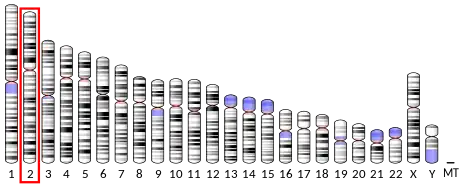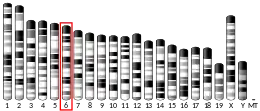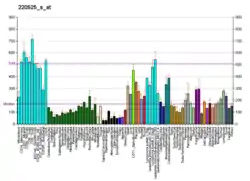AUP1
Ancient ubiquitous protein 1 is a protein that in humans is encoded by the AUP1 gene.[5][6][7]
| AUP1 | |||||||||||||||||||||||||||||||||||||||||||||||||||
|---|---|---|---|---|---|---|---|---|---|---|---|---|---|---|---|---|---|---|---|---|---|---|---|---|---|---|---|---|---|---|---|---|---|---|---|---|---|---|---|---|---|---|---|---|---|---|---|---|---|---|---|
| |||||||||||||||||||||||||||||||||||||||||||||||||||
| Identifiers | |||||||||||||||||||||||||||||||||||||||||||||||||||
| Aliases | AUP1, ancient ubiquitous protein 1, lipid droplet regulating VLDL assembly factor, AUP1 lipid droplet regulating VLDL assembly factor | ||||||||||||||||||||||||||||||||||||||||||||||||||
| External IDs | OMIM: 602434 MGI: 107789 HomoloGene: 7239 GeneCards: AUP1 | ||||||||||||||||||||||||||||||||||||||||||||||||||
| |||||||||||||||||||||||||||||||||||||||||||||||||||
| |||||||||||||||||||||||||||||||||||||||||||||||||||
| |||||||||||||||||||||||||||||||||||||||||||||||||||
| |||||||||||||||||||||||||||||||||||||||||||||||||||
| |||||||||||||||||||||||||||||||||||||||||||||||||||
| Wikidata | |||||||||||||||||||||||||||||||||||||||||||||||||||
| |||||||||||||||||||||||||||||||||||||||||||||||||||
Function
This gene encodes a protein that contains a domain with homology to the ancient conserved region of the archain 1 gene and a domain that may be involved in binding ubiquitin-conjugating enzymes. The protein encoded by this gene has been shown to bind to the conserved membrane-proximal sequence of the cytoplasmic tail of integrin alpha (IIb) subunits. These subunits play a crucial role in the integrin alpha (IIb) beta (3) inside-out signalling in platelets and megakaryocytes that leads to platelet aggregation and thrombus formation. This gene overlaps the gene for mitochondrial serine protease 25.[7]
References
- GRCh38: Ensembl release 89: ENSG00000115307 - Ensembl, May 2017
- GRCm38: Ensembl release 89: ENSMUSG00000068328 - Ensembl, May 2017
- "Human PubMed Reference:". National Center for Biotechnology Information, U.S. National Library of Medicine.
- "Mouse PubMed Reference:". National Center for Biotechnology Information, U.S. National Library of Medicine.
- Jang W, Weber JS, Bashir R, Bushby K, Meisler MH (Jan 1997). "Aup1, a novel gene on mouse chromosome 6 and human chromosome 2p13". Genomics. 36 (2): 366–8. doi:10.1006/geno.1996.0477. PMID 8812468.
- Kato A, Kawamata N, Tamayose K, Egashira M, Miura R, Fujimura T, Murayama K, Oshimi K (Aug 2002). "Ancient ubiquitous protein 1 binds to the conserved membrane-proximal sequence of the cytoplasmic tail of the integrin alpha subunits that plays a crucial role in the inside-out signaling of alpha IIbbeta 3". J Biol Chem. 277 (32): 28934–41. doi:10.1074/jbc.M204340200. PMID 12042322.
- "Entrez Gene: AUP1 ancient ubiquitous protein 1".
External links
Further reading
- Ewing RM, Chu P, Elisma F, Li H, Taylor P, Climie S, McBroom-Cerajewski L, Robinson MD, O'Connor L, Li M, Taylor R, Dharsee M, Ho Y, Heilbut A, Moore L, Zhang S, Ornatsky O, Bukhman YV, Ethier M, Sheng Y, Vasilescu J, Abu-Farha M, Lambert JP, Duewel HS, Stewart II, Kuehl B, Hogue K, Colwill K, Gladwish K, Muskat B, Kinach R, Adams SL, Moran MF, Morin GB, Topaloglou T, Figeys D (2007). "Large-scale mapping of human protein-protein interactions by mass spectrometry". Mol. Syst. Biol. 3 (1): 89. doi:10.1038/msb4100134. PMC 1847948. PMID 17353931.
- Karpisheva KV, Tauber B, Kisliakova TV, Dobner T (2003). "[A new human cellular protein AUP1. III. The intracellular localization of AUP1 protein in different human and rat cell lines]". Tsitologiia. 44 (9): 846–51. PMID 12534238.
- Karpisheva KV, Touber B, Kisliakova TV, Dobner T (2003). "[A new human cellular protein AUP1. II. cDNA cloning, genomic organization of Aup1 gene ans [sic] preliminary characterization of human AUP1 protein]". Tsitologiia. 44 (9): 839–45. PMID 12534237.
- Zhang QH, Ye M, Wu XY, Ren SX, Zhao M, Zhao CJ, Fu G, Shen Y, Fan HY, Lu G, Zhong M, Xu XR, Han ZG, Zhang JW, Tao J, Huang QH, Zhou J, Hu GX, Gu J, Chen SJ, Chen Z (2001). "Cloning and functional analysis of cDNAs with open reading frames for 300 previously undefined genes expressed in CD34+ hematopoietic stem/progenitor cells". Genome Res. 10 (10): 1546–60. doi:10.1101/gr.140200. PMC 310934. PMID 11042152.
This article is issued from Wikipedia. The text is licensed under Creative Commons - Attribution - Sharealike. Additional terms may apply for the media files.




